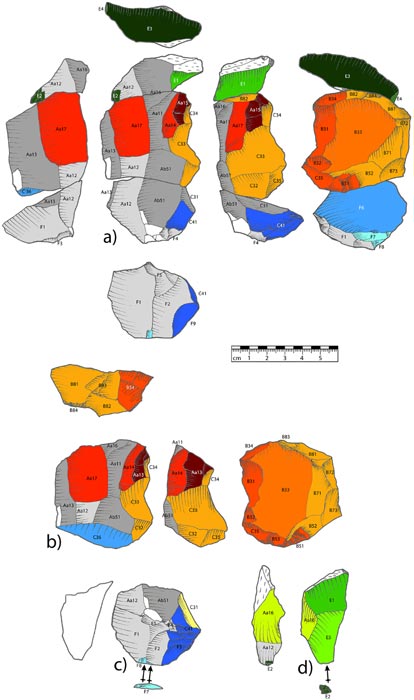Between 52,000 and 45,000 years ago, Neanderthal hunters in the Swabian Alps, in southwestern Germany, possessed “great mental flexibility” concludes the latest study. The study authors go on to say, Neanderthal hunter toolmakers applied a “great working memory, mental flexibility and adaptability, coupled with manual dexterity.” These new findings were made by a team of researchers from the University of Tübingen who recently published their research paper on Neanderthal hunter toolmaking in the journal Plos One .
Essentially, the new study looks at how Neanderthals in the Middle Paleolithic manufactured hunting tools, using a repeatable production system. The team of researchers identified a slate of evidence demonstrating “well thought-out manufacturing processes.” Until now, such mental abilities and signs of organized community teamwork among Neanderthal communities were only suspected. But now, these new findings are thought to explain the wide range of “advanced” stone artifacts that have been recovered from Middle Paleolithic Neanderthal sites.

German amateur archaeologist Hermann Mohn at the Neanderthal hunting camp in the Swabian Alps’ which he discovered in 1928 ( University of Tübingen )
Neanderthal Hunters And Their Flexible Toolmaking Process
Lead author of the new study, Professor Berrin Çep, explained in the paper that all of the new evidence was collected from the Middle Paleolithic Heidenschmiede rock shelter. Located near An der Brenz, a borough of Sontheim village in the Heidenheim District of Baden-Württemberg in Germany, this ancient hunters camp was discovered in 1928 by local amateur archaeologist Hermann Mohn (1896-1958) in 1928.
The site was first excavated in 1930 by Eduard Peters and Coauthor Benjamin Schürch, from the Institute for Prehistory and Early History and Archaeology of the Middle Ages at the University of Tübingen. They said the bone and stone tools recovered from the site in 1930 are “at least 50,000 to 42,000 years old.”
Professor Schürch said that at this time no Homo sapiens (modern humans) existed in the region, and that the Heidenschmiede site was a center of late Neanderthal hunting . The Neanderthals crafted “blades, scrapers and wedge knives” from stone and bone, and evidence of leather working was also identified. The team of researchers concluded that the Neanderthals had developed and used a range of “different concepts” to manufacture such tools, wrote lead author Professor Berrin Çep.

Figure 5 from the recent Plos One research study on Neanderthal hunters and their toolmaking processes. This figure shows drawings of the refitted core reduction sequence: a) drawing of the three pieces, refitted; b) blade/Levallois core of the middle volume; c) core cap of the lower volume; d) core-edge blank of the upper volume. ( Plos One )
The Cores: Cutting Edge Tools First and Then Other Tools
The researchers studied lumps of worked flint, known as “cores,” that had been used to make arrow blades and other basic cutting edges. The cores were then further processed into smaller and smaller tools, said Çep. This is something that archaeologists would more often find at Neolithic European farming settlements dating to 3,000 BC. This method of using and reusing a lump of flint until no more effective flakes can be chipped is known as a “branched reduction system.”
The study authors state, a “branched reduction system” is when single pieces of flint were processed differently, “according to various concepts.” The hunters knew a “whole reservoir” of production methodologies, explained Schürch. This has “rarely been proven from the Middle Paleolithic,” said study coauthor Jens Axel Frick, who added that the new evidence represents a first for the Swabian Alps .

The process of flintknapping a core one flake at a time, a process known to be used by Neanderthals but not as advanced as the branched reduction system that has now been proven by the latest study to be well understood by late Neanderthals. (Tonto National Monument / CC BY 2.0 )
Neanderthals Branching Into The Future
Why are these different and varied production processes such a big deal? Because it has informed archaeologists that late Neanderthal’s were predicting relatively complicated outcomes in their stone making processes. Anyone who has chipped flints knows that the number one most important step after boiling the stone to soften it, is to “stone gaze,” before a single flint is chipped.
You must first spend time assessing the flaws, fractures and mineral weaknesses in the flint, predicting how it will flake when chipped. Good gazing, and predicting how the stone will break down, means you the flintknapper, extracts the highest amount of usable blades and the least amount of waste from a single core.
When gazing at a flint core you are not only looking at one surface: you have to follow the cracks though the stone. One must notice where flaw lines cross, bend, widen and thin.
Professor Berrin Çep wrote in the new paper than these skills require “a strong three-dimensional imagination, creativity and mentally flexible planning.” Furthermore, to have repeated all the required skills, techniques, tricks, and tactics to have reproduced such a wide range of survival devices, tools and weapons, the Heidenschmiede Neanderthals must have had “an excellent working memory,” concluded the researchers.
The new study results provide the first demonstrable evidence of Neanderthals applying “mental flexibility and adaptability, coupled with manual dexterity.” Moreover, these so-called “branched manufacturing processes” also offer answers for why there was an explosion in stone artifact production in the Middle Paleolithic era.
Top image: Middle Paleolithic flint cores from the Sontheim Neanderthal hunters camp in southwest German: By reassembling the original flint stone, the research team was able to understand the Neanderthal’s branched production concept. Source: University of Tübingen
By Ashley Cowie
Related posts:
Views: 0
 RSS Feed
RSS Feed















 September 10th, 2021
September 10th, 2021  Awake Goy
Awake Goy  Posted in
Posted in  Tags:
Tags: 
















